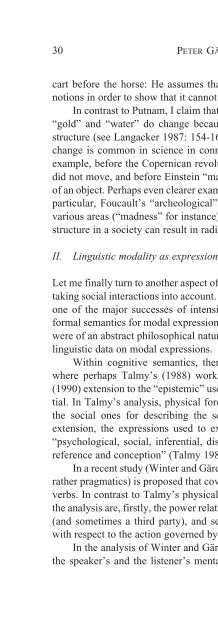Cognitive Semantics : Meaning and Cognition
Cognitive Semantics : Meaning and Cognition
Cognitive Semantics : Meaning and Cognition
Create successful ePaper yourself
Turn your PDF publications into a flip-book with our unique Google optimized e-Paper software.
knowledge, <strong>and</strong> non-underst<strong>and</strong>ing, etc.<br />
FROM VISION TO COGNITION 69<br />
sikta på ‘aim at’ intention<br />
framsynt ‘far-sighted’ attitude to knowledge<br />
vara blind ‘being blind’ inability to underst<strong>and</strong><br />
Visual expressions may thus be employed to express very many aspects of<br />
cognition where “knowledge” is perhaps only one of the most abstract concepts.<br />
My last comment concerns the conceptual analysis of vision. Sweetser<br />
seems to consider ‘sight’ as a primitive concept. This is somewhat inadequate<br />
as a semantic analysis. Sight presupposes the ability to perceive light. Thus,<br />
we use the expression he could no longer see to refer to a situation where an<br />
individual has lost the ability to perceive light. In my semantic field analysis<br />
(section 4), I will accordingly underst<strong>and</strong> the concept ‘light’ as more basic<br />
than ‘sight’ or ‘seeing’.<br />
3. Aim of the study<br />
Taking the critical remarks above as a starting-point, my aim was to explore<br />
what different aspects of cognition are expressed metaphorically, or polysemically,<br />
in Swedish by the aid of expressions connected with visual perception.<br />
The study was not restricted to verbs but included all kinds of lexemes<br />
connected with light. The investigation was entirely based on information in<br />
Swedish dictionaries concerned with synonymy.<br />
The difference between the present study <strong>and</strong> studies by writers such as<br />
Viberg (1980) is that, while Viberg’s interest is focused on the Swedish<br />
expressions from a typological point of view, my study is clearly more<br />
language-specific with the ultimate aim of formulating some hypotheses<br />
which can be investigated in other languages.<br />
4. The semantic field of visual perception<br />
What follows in this section is an attempt to underst<strong>and</strong> how language structures<br />
the domain of visual perception. I would like to characterize my analysis<br />
as “folk semantic”, in that it makes an abstraction away from much of the















